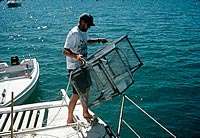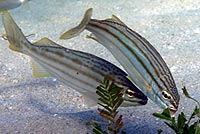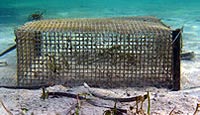
Research Projects – Fish Communities

Fish studies in Shark Bay




The seagrass beds of Shark Bay provide a home for many species of fishes. So far, most of our work on fishes has been aimed at understanding their distribution for studies of dolphins and cormorants. In these studies, we used Antellian-Z style fish traps (60cmx60cmx100cm) baited with cut fish. Up to twelve traps were set in deep and shallow habitats at the same time and were allowed to soak for two hours before they were retrieved. We then identified and measured each fish and weighed a subsample to determine length-weight relationships.
We captured 31 species from seagrass and sand habitats in both deep and shallow waters. Western butterfish and striped trumpeters are, by far, the most common species in our seagrass study area but other species like pink snapper, yellowtail trumpeters, tarwhine, leatherjacks, and toadfish are also common. Overall, there is a much higher biomass of fishes found over the shallow seagrass banks than in deeper waters or sandy habitats of the shallow banks. This pattern is stable throughout the year.
Based on recent observations that striped trumpeters may actually consume some species of seagrasses preferentially, we have initiated more detailed studies of the fish communities in Shark Bay. These include seagrass preference trials, exclosure studies, and video monitoring to determine patterns of fish abundance and behavior. Check back later to learn more about some of the following questions:
- How do fishes respond to predation risk from dolphins, cormorants, sea snakes, small sharks, and other bony fishes?
- Which fish species are common grazers of seagrass in Shark Bay?
- How does grazing by fishes influence the structure of seagrass communities and do fishes help to transmit indirect effects of tiger sharks to seagrasses? See our Indirect effects page for more on this study
- What is the trophic structure of the fish community in seagrass habitats and fringing mangrove habitats?
Fish Studies Publications
- Burkholder, D. A., M. R. Heithaus, and J. A. Fourqurean. 2012. Feeding preferences of herbivores in a relatively pristine subtropical seagrass ecosystem. Marine and Freshwater Research 63: 1051-1058.
- Belicka, L. L., D. Burkholder, J. W. Fourqurean, M.R. Heithaus, S. A. Macko and R. Jaffé. 2012. Stable isotope and fatty acid biomarkers of seagrass, epiphytic, and algal organic matter to consumers in a nearly pristine seagrass ecosystem. Marine and Freshwater Research 63: 1085-1097.
- Heithaus, M. R. and L. M. Dill. 2006. Does tiger shark predation risk influence foraging habitat use by bottlenose dolphins at multiple spatial scales? Oikos 114: 257-264.
- Rova, A., G. Mori, and L. M. Dill. 2007. One fish, two fish, butterfish, trumpeter: recognizing fish in underwater video. IAPR Conference on Machine Vision Applications, 2007.
- Heithaus, M. R. 2005. Habitat use and group size of pied cormorants (Phalacrocorax varius) in a sea grass ecosystem: possible effects of food abundance and predation risk. Marine Biology 147: 27-35.
- Heithaus, M. R. 2004. Fish communities of seagrass meadows and associated habitats in Shark Bay, Western Australia. Bulletin of Marine Science 75: 79-99.
- Heithaus, M. R. and L. M. Dill. 2002. Food availability and tiger shark predation risk influence bottlenose dolphin habitat use. Ecology 83: 480-491.
All photographs copyrighted; Images may be used for educational purposes. For use in other forms contact Mike Heithaus

